Biodegradation of Alprazolam in Pharmaceutical Wastewater Using Mesoporous Nanoparticles-Adhered Pseudomonas stutzeri
Abstract
1. Introduction
2. Results and Discussion
2.1. Isolation and Screening of Alprazolam-Degrading Bacteria
2.2. Molecular Identification of the Isolated Strain
2.3. Characterization of MSN
2.4. Effect of Alprazolam Concentration and pH on Bacterial Growth and Alprazolam Biodegradation
2.5. Biodegradation of Alprazolam by the MSN-Adhered Bacteria
2.6. Kinetic Modeling
2.7. Thermodynamic Study
3. Materials and Methods
3.1. Preparation of Alprazolam Stock Solution
3.2. Sampling and Isolation of Bacteria
3.3. Selecting Alprazolam-Degrading Bacteria
3.4. Bacterial Recognition
3.5. Effect of Alprazolam Concentration on the Bacterial Growth
3.6. Assessing the Biodegradation of Alprazolam by Bacteria
3.7. Synthesizing MSN and Its Immobilization on Bacterial Cells
3.8. Alprazolam Biodegrading by MSN-Adhered Bacteria
3.9. Analysis Method
3.10. Statistical Analysis
4. Conclusions
Author Contributions
Funding
Institutional Review Board Statement
Informed Consent Statement
Data Availability Statement
Acknowledgments
Conflicts of Interest
Sample Availability
References
- Hignite, C.; Azarnoff, D.L. Drugs and drug metabolites as environmental contaminants: Chlorophenoxyisobutyrate and salicylic acid in sewage water effluent. Life Sci. 1977, 2, 337–341. [Google Scholar] [CrossRef]
- Zamani, H.; Grakoee, S.R.; Rakhshaee, R. Microbial degradation of Paclitaxel using Citrobacter amalonaticus Rashtia isolated from pharmaceutical wastewater: Kinetic and thermodynamic study. World J. Microbiol. Biotechnol. 2016, 2, 129. [Google Scholar] [CrossRef] [PubMed]
- Besse, J.-P.; Latour, J.-F.; Garric, J. Anticancer drugs in surface waters: What can we say about the occurrence and environmental significance of cytotoxic, cytostatic and endocrine therapy drugs? Environ. Int. 2012, 2, 73–86. [Google Scholar] [CrossRef]
- Zhang, J.; Chang, V.W.C.; Giannis, A.; Wang, J.-Y. Removal of cytostatic drugs from aquatic environment: A review. Sci. Total Environ. 2013, 2, 281–298. [Google Scholar] [CrossRef] [PubMed]
- Chen, H. Recent advances in azo dye degrading enzyme research. Curr. Protein Pept. Sci. 2006, 2, 101–111. [Google Scholar] [CrossRef]
- Forgacs, E.; Cserháti, T.; Oros, G. Removal of synthetic dyes from wastewaters: A review. Environ. Int. 2004, 2, 953–971. [Google Scholar] [CrossRef] [PubMed]
- Hoffmann, F.; Cornelius, M.; Morell, J.; Fröba, M. Silica-Based Mesoporous Organic–Inorganic Hybrid Materials. Angew. Chem. Int. Ed. 2006, 2, 3216–3251. [Google Scholar] [CrossRef]
- Aissaoui, S.; Ouled-Haddar, H.; Sifour, M.; Beggah, C.; Benhamada, F. Biological Removal of the Mixed Pharmaceuticals: Diclofenac, Ibuprofen, and Sulfamethoxazole Using a Bacterial Consortium. Iran. J. Biotechnol. 2017, 2, 135–142. [Google Scholar] [CrossRef]
- Yang, C.-W.; Liu, C.; Chang, B.-V. Biodegradation of Amoxicillin, Tetracyclines and Sulfonamides in Wastewater Sludge. Water 2020, 12, 2147. [Google Scholar] [CrossRef]
- Kumar, S.; Ahlawat, W.; Bhanjana, G.; Heydarifard, S.; Nazhad, M.M.; Dilbaghi, N. Nanotechnology-based water treatment strategies. J. Nanosci. Nanotechnol. 2014, 2, 1838–1858. [Google Scholar] [CrossRef] [PubMed]
- Cecchin, I.; Reddy, K.R.; Thomé, A.; Tessaro, E.F.; Schnaid, F. Nanobioremediation: Integration of nanoparticles and bioremediation for sustainable remediation of chlorinated organic contaminants in soils. Int. Biodeterior. Biodegrad. 2017, 2, 419–428. [Google Scholar] [CrossRef]
- Sarioglu, O.F.; Celebioglu, A.; Tekinay, T.; Uyar, T. Evaluation of contact time and fiber morphology on bacterial immobilization for development of novel surfactant degrading nanofibrous webs. RSC Adv. 2015, 2, 102750–102758. [Google Scholar] [CrossRef]
- He, S.; Zhong, L.; Duan, J.; Feng, Y.; Yang, B.; Yang, L. Bioremediation of Wastewater by Iron Oxide-Biochar Nanocomposites Loaded with Photosynthetic Bacteria. Front. Microbiol. 2017, 8, 823. [Google Scholar] [CrossRef]
- Khatoon, H.; Rai, J.P.N. Augmentation of Atrazine biodegradation by two Bacilli immobilized on α-Fe2O3 magnetic nanoparticles. Sci. Rep. 2018, 2, 17831. [Google Scholar] [CrossRef]
- Huang, S.; Tang, J.; Liu, X.; Dong, G.; Zhou, S. Fast Light-Driven Biodecolorization by a Geobacter sulfurreducens–CdS Biohybrid. ACS Sustain. Chem. Eng. 2019, 2, 15427–15433. [Google Scholar] [CrossRef]
- Metcalfe, C.D.; Koenig, B.G.; Bennie, D.T.; Servos, M.; Ternes, T.A.; Hirsch, R. Occurrence of neutral and acidic drugs in the effluents of Canadian sewage treatment plants. Environ. Toxicol. Chem. 2003, 2, 2872–2880. [Google Scholar] [CrossRef] [PubMed]
- Verster, J.C.; Volkerts, E.R. Clinical Pharmacology, Clinical Efficacy, and Behavioral Toxicity of Alprazolam: A Review of the Literature. CNS Drug Rev. 2004, 2, 45–76. [Google Scholar] [CrossRef] [PubMed]
- Romeiro, A.; Freitas, D.; Azenha, M.E.; Canle, M.; Burrows, H.D. Effect of the calcination temperature on the photocatalytic efficiency of acidic sol–gel synthesized TiO2 nanoparticles in the degradation of alprazolam. Photochem. Photobiol. Sci. 2017, 2, 935–945. [Google Scholar] [CrossRef] [PubMed]
- Rosenholm, J.M.; Sahlgren, C.; Lindén, M. Towards multifunctional, targeted drug delivery systems using mesoporous silica nanoparticles–opportunities & challenges. Nanoscale 2010, 2, 1870–1883. [Google Scholar] [CrossRef]
- Li, Z.; Ma, J.; Ruan, J.; Zhuang, X. Using Positively Charged Magnetic Nanoparticles to Capture Bacteria at Ultralow Concentration. Res. Lett. 2019, 2, 195. [Google Scholar] [CrossRef] [PubMed]
- Sapino, S.; Ugazio, E.; Gastaldi, L.; Miletto, I.; Berlier, G.; Zonari, D.; Oliaro-Bosso, S. Mesoporous silica as topical nanocarriers for quercetin: Characterization and in vitro studies. Eur. J. Pharm. Biopharm. 2015, 2, 116–125. [Google Scholar] [CrossRef] [PubMed]
- Gomaa, E.Z. Biodegradation and Detoxification of Azo Dyes by Some Bacterial Strains. Microbiol. J. 2015, 2, 15–24. [Google Scholar] [CrossRef][Green Version]
- Ahmad Nor, Y.; Niu, Y.; Karmakar, S.; Zhou, L.; Xu, C.; Zhang, J.; Zhang, H.; Yu, M.; Mahony, D.; Mitter, N.; et al. Shaping Nanoparticles with Hydrophilic Compositions and Hydrophobic Properties as Nanocarriers for Antibiotic Delivery. ACS Cent. Sci. 2015, 2, 328–334. [Google Scholar] [CrossRef] [PubMed]
- Lemire, J.A.; Harrison, J.J.; Turner, R.J. Antimicrobial activity of metals: Mechanisms, molecular targets and applications. Nat. Rev. Microbiol. 2013, 2, 371–384. [Google Scholar] [CrossRef] [PubMed]
- Żur, J.; Wojcieszyńska, D.; Guzik, U. Metabolic Responses of Bacterial Cells to Immobilization. Molecules 2016, 21, 958. [Google Scholar] [CrossRef] [PubMed]
- Shahriarinour, M.; Divsar, F.; Eskandari, Z. Synthesis, characterization, and antibacterial activity of thymol loaded SBA-15 mesoporous silica nanoparticles. Inorg. Nano-Met. Chem. 2019, 2, 182–189. [Google Scholar] [CrossRef]

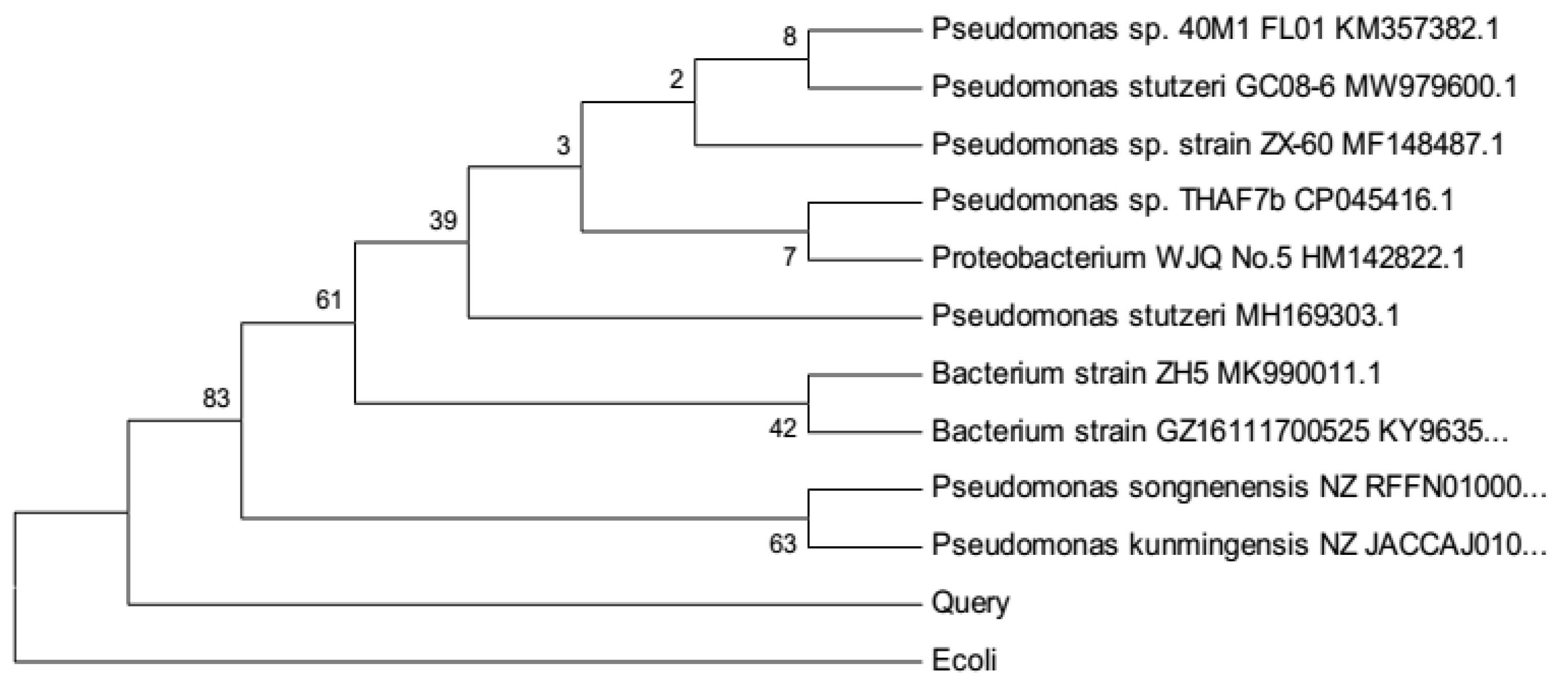


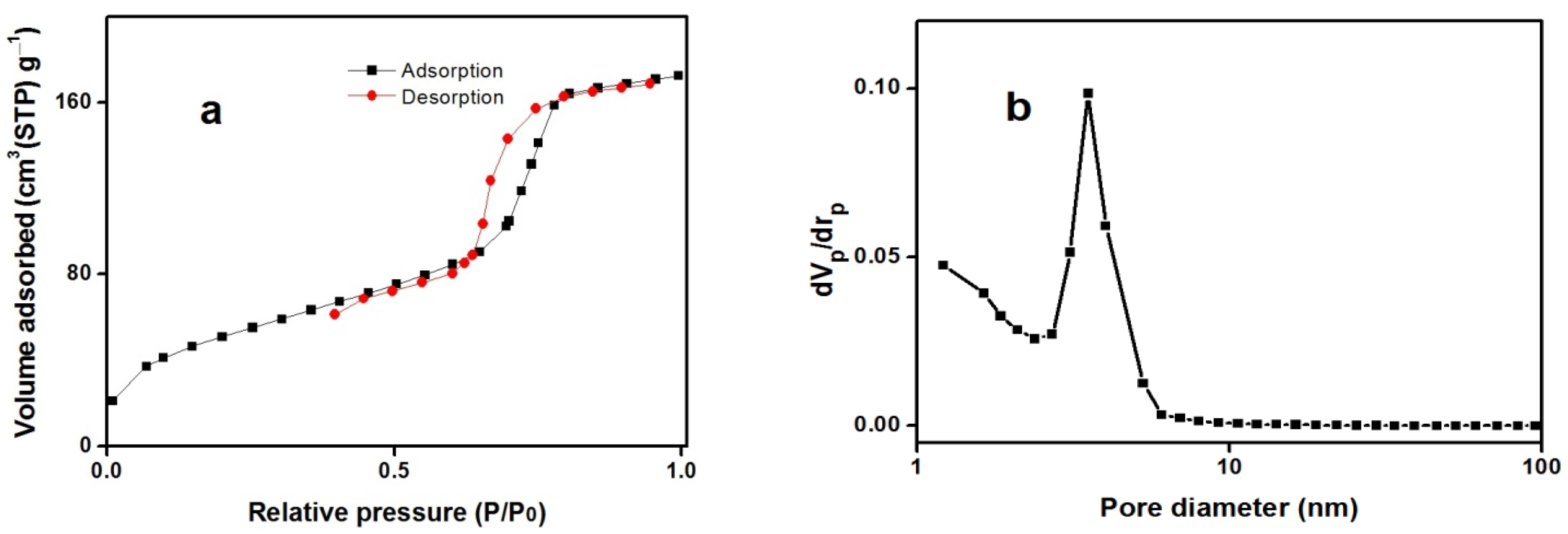
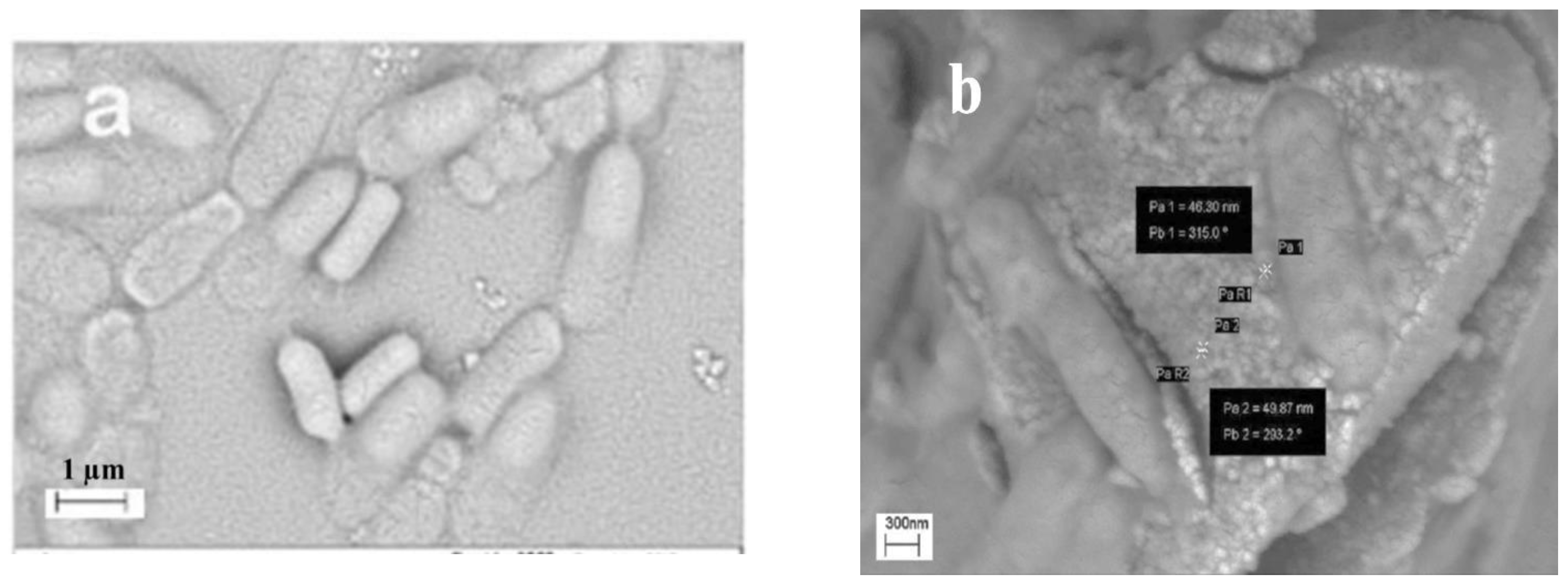
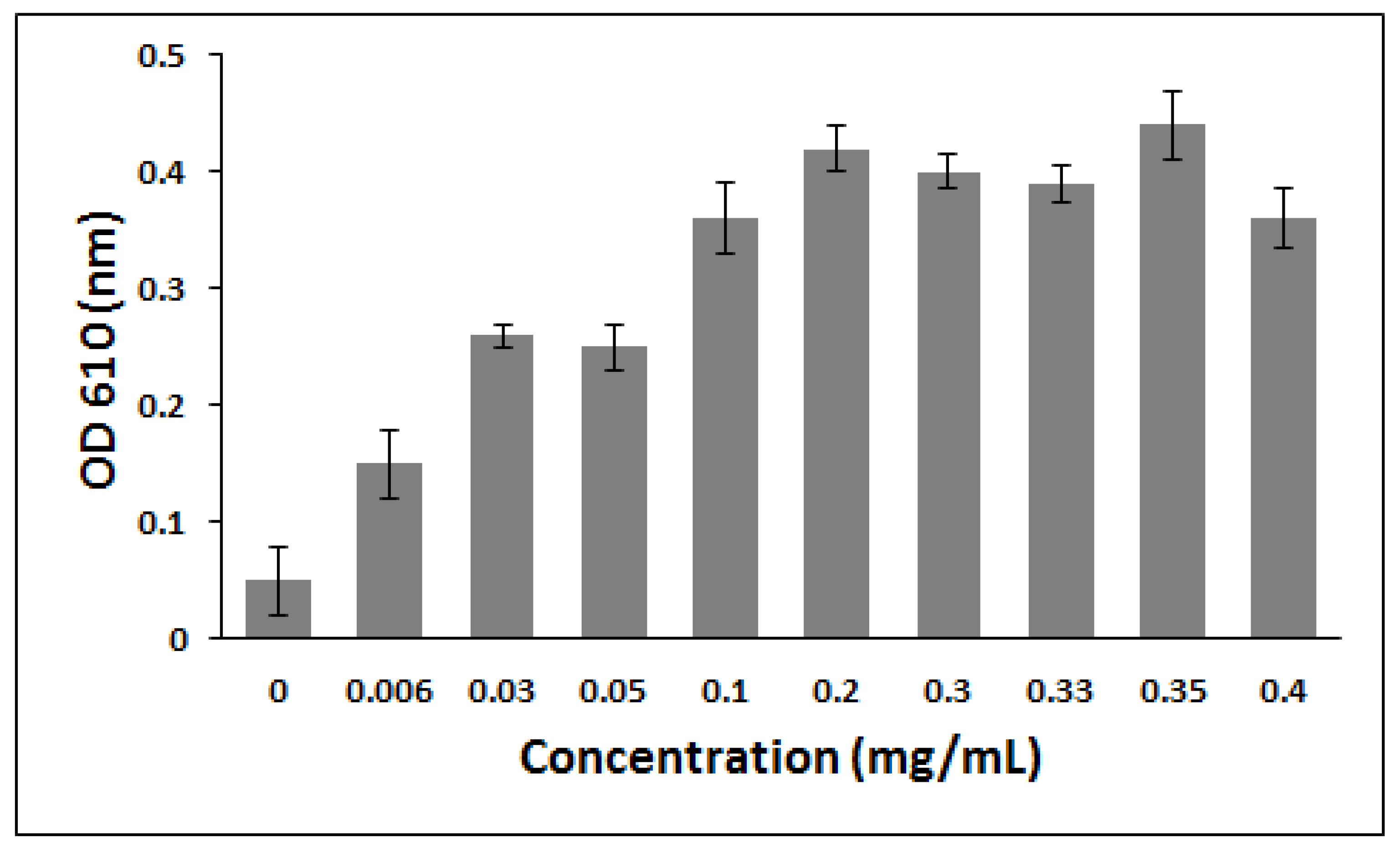



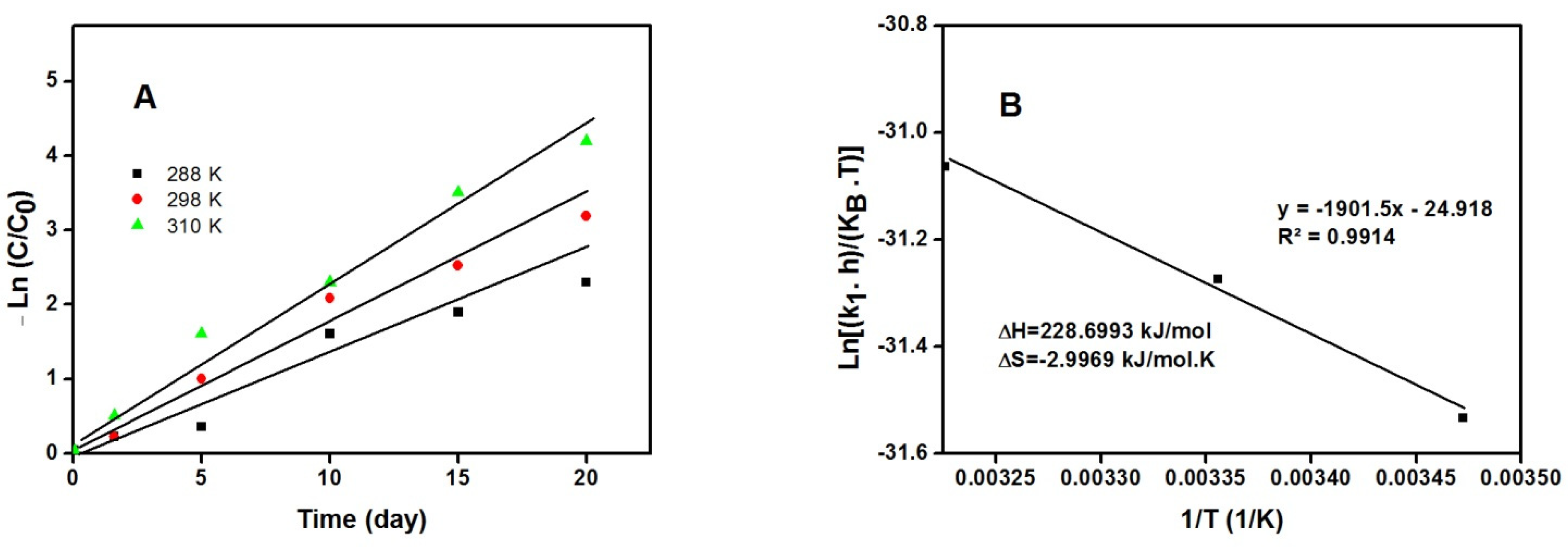
| Test | Oxidase | Motility | Nitrate | Urease | Citrate | Indole | H2S | Gram Staining | l-Arabinose | D-Glucose |
|---|---|---|---|---|---|---|---|---|---|---|
| Result | + | + | + | − | + | − | − | − | − | + |
| Y = ax + b | k1 | R2 | ||
|---|---|---|---|---|
| First order | MSN | y = 0.0072x + 0.8545 | 0.0072 | 0.0345 |
| Bacteria | y = 0.1263x – 0.0011 | 0.1263 | 0.9744 | |
| Bacteria–MSN | y = 0.1628x + 0.1171 | 0.1628 | 0.9736 | |
| Second order | MSN | y = 0.0001x + 0.0237 | 0.0001 | 0.0217 |
| Bacteria | y = 0.0047x + 0.0017 | 0.0047 | 0.97 | |
| Bacteria–MSN | y = 0.0109x – 0.0127 | 0.0109 | 0.9189 |
Publisher’s Note: MDPI stays neutral with regard to jurisdictional claims in published maps and institutional affiliations. |
© 2021 by the authors. Licensee MDPI, Basel, Switzerland. This article is an open access article distributed under the terms and conditions of the Creative Commons Attribution (CC BY) license (https://creativecommons.org/licenses/by/4.0/).
Share and Cite
Shahriarinour, M.; Divsar, F.; Dahka, F.K.; Chegini, S.N.; Mahani, M.; Moeini, A.; Cerruti, P. Biodegradation of Alprazolam in Pharmaceutical Wastewater Using Mesoporous Nanoparticles-Adhered Pseudomonas stutzeri. Molecules 2022, 27, 237. https://doi.org/10.3390/molecules27010237
Shahriarinour M, Divsar F, Dahka FK, Chegini SN, Mahani M, Moeini A, Cerruti P. Biodegradation of Alprazolam in Pharmaceutical Wastewater Using Mesoporous Nanoparticles-Adhered Pseudomonas stutzeri. Molecules. 2022; 27(1):237. https://doi.org/10.3390/molecules27010237
Chicago/Turabian StyleShahriarinour, Mahdi, Faten Divsar, Fereshteh Kamalpour Dahka, Sharareh Nezamivand Chegini, Mohamad Mahani, Arash Moeini, and Pierfrancesco Cerruti. 2022. "Biodegradation of Alprazolam in Pharmaceutical Wastewater Using Mesoporous Nanoparticles-Adhered Pseudomonas stutzeri" Molecules 27, no. 1: 237. https://doi.org/10.3390/molecules27010237
APA StyleShahriarinour, M., Divsar, F., Dahka, F. K., Chegini, S. N., Mahani, M., Moeini, A., & Cerruti, P. (2022). Biodegradation of Alprazolam in Pharmaceutical Wastewater Using Mesoporous Nanoparticles-Adhered Pseudomonas stutzeri. Molecules, 27(1), 237. https://doi.org/10.3390/molecules27010237









